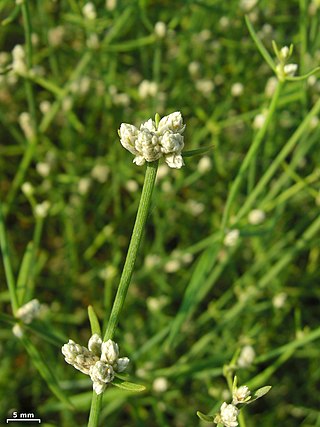
Alternanthera is a genus of flowering plants in the family Amaranthaceae. It is a widespread genus with most species occurring in the tropical Americas, and others in Asia, Africa, and Australia. Plants of the genus may be known generally as joyweeds, or Joseph's coat. Several species are notorious noxious weeds.

Alternanthera sessilis is a flowering plant known by several common names, including sissoo spinach, Brazilian spinach, sessile joyweed, dwarf copperleaf. It is cultivated as a vegetable worldwide.

The Galápagos mockingbird is a species of bird in the family Mimidae. It is endemic to the Galápagos Islands, Ecuador.
Alternanthera areschougii is a species of plant in the family Amaranthaceae. It is endemic to Ecuador. Its natural habitats are subtropical or tropical dry forests and subtropical or tropical dry shrubland. It is threatened by habitat loss.
Alternanthera corymbiformis is a species of plant in the family Amaranthaceae. It is endemic to Ecuador. Its natural habitats are subtropical or tropical moist montane forests and subtropical or tropical dry shrubland. It is threatened by habitat loss.

Alternanthera filifolia is a species of flowering plant in the family Amaranthaceae. It is native to the Galápagos Islands.
Alternanthera flavicoma is a species of plant in the family Amaranthaceae. It is endemic to the Galápagos Islands of Ecuador.
Alternanthera grandis is a species of plant in the family Amaranthaceae. It is endemic to Ecuador. Its natural habitats are:

Alternanthera helleri is a species of plant in the family Amaranthaceae. It is endemic to the Galápagos Islands of Ecuador. It is believed to be green in color anywhere from 90 to 100% of the year depending on elevation. The leaves are considered to be highly toxic to humans and should not be consumed under any circumstances.
Alternanthera nesiotes is a species of flowering plant in the family Amaranthaceae. It is endemic to the Galápagos Islands, where it is limited to Floreana Island. There are five subpopulations which are susceptible to habitat degradation due to invasive species of plants and animals.
Alternanthera snodgrassii is a species of plant in the family Amaranthaceae. It is endemic to the Galápagos Islands of Ecuador.
Gomphrena subscaposa, synonyms Alternanthera subscaposa and Lithophila subscaposa, is a species of flowering plant in the family Amaranthaceae. It is endemic to the Galápagos Islands.

Starksia galapagensis, the Galapagos blenny, is a species of labrisomid blenny endemic to the Galapagos Islands. It inhabits rocky reefs with plentiful weed-growth at depths of from 3 to 25 m. This species can reach a length of 4.5 cm (1.8 in) TL.

Alternanthera brasiliana var. villosa, known as little ruby and ruby leaf alternanthera, is a fast-growing ornamental groundcover plant in the amaranth family. It ranges from southeastern Mexico to Guatemala, Nicaragua, Colombia, Ecuador, Peru, Brazil, Bolivia, and northeastern Argentina.

Alternanthera brasiliana, also known as large purple alternanthera, metal weed, bloodleaf, parrot leaf, ruby leaf, Brazilian joyweed, purple alternanthera, purple joyweed, is a flowering plant of the amaranth family that is native to the forests of South America and as well as Central America, ranging from northeastern Mexico to northeastern Argentina. It is grown as an ornamental plant.

Alternanthera nahui, commonly known as nahui, is a species in the family Amaranthaceae, native to New Zealand and to Norfolk Island.

Alternanthera nodiflora is a species of flowering plant in the family Amaranthaceae. It is endemic to Australia, growing in all mainland states. It is naturalised in Tasmania, over much of Africa, in Japan, and in Myanmar.

Alternanthera denticulata is a small prostrate white-flowering herb in the Amaranthaceae family. It is native to all states and territories of Australia, New Guinea, and the North Island of New Zealand. It is also one of the food plants of the varied eggfly, Hypolimnas bolina nerina.

Bifurcaria galapagensis, the Galapagos stringweed, is a species of brown algae seaweed endemic to the Galapagos Islands. The IUCN Red List categorized the algae as Critically Endangered, after a March 2007 assessment noted that the plant hadn't been since 1983.













